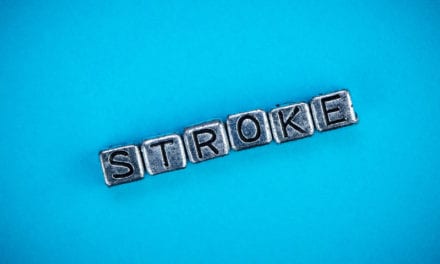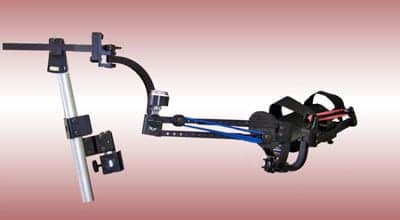Every 40 ticks, an individual in the USA suffers a stroke. As per the U.S. Centers for Disease Control and Prevention, this adds up to roughly 795,000 strokes annually. Over 80% of stroke survivors confront difficulties in walking, frequently due to a decline in managing ankle motion. As survivors advance into the long-term phase of stroke, the majority tend to walk at a reduced pace and with diminished efficiency. A portable, flexible, and user-friendly ankle exosuit has the potential to change this situation.
Specifically designed for autonomous usage in local environments, this innovative exosuit has the capacity to assist stroke survivors in enhancing their walking capabilities beyond laboratory settings and in their everyday routines – and in their rehabilitation program.
Related: FDA Clears ReWalk Personal Exoskeleton for Stairs and Curbs
A preliminary study demonstrates that the ankle exosuit, intended for community use, can aid stroke survivors in improving their walking propulsion, increasing overall confidence while ambulating, and enhancing their ability to navigate within their residences, workplaces, and neighborhoods. The research, spearheaded by Conor Walsh’s team at the Harvard John A. Paulson School of Engineering and Applied Sciences (SEAS), is now available in the online edition of the Annals of the New York Academy of Sciences.
New research indicates that individuals recovering from strokes can enhance their walking speed, distance, propulsion, and symmetry of gait through the utilization of a robotic exosuit. However, it is worth noting that these studies have solely taken place within controlled laboratory or clinical environments.
Walsh, the senior author of the paper and the Paul A. Maeder Professor of Engineering and Applied Sciences at SEAS, expresses their enthusiasm for employing wearable technology to redefine the approach to physical therapy and rehabilitation. They believe that by transitioning certain clinical services from traditional clinic settings to patients’ homes and communities, it is possible to enhance accessibility, lower costs, and provide superior care. The collaboration between the fields of engineering and physical therapy in achieving this goal is seen as an exciting development.
For more than 10 years, Walsh’s Biodesign Lab at Harvard has been actively involved in the development of assistive and rehabilitative exosuit technologies for diverse purposes. Certain aspects of this technology have already been licensed and brought to the market by ReWalk Robotics, and they have received significant recognition by obtaining breakthrough status from the U.S. Food and Drug Administration.
In order to create an ankle exosuit specifically intended for community use, Walsh’s team must streamline the mechanical components of the exosuit and ensure that wearers can easily control its functionality. Simplifying the design and enhancing user-friendliness are key objectives for the team.
Richard Nuckols, a former postdoctoral fellow in Walsh’s lab at SEAS and co-first author of the paper, explains that previous iterations of their ankle exosuits incorporated two active actuators. One actuator aided in dorsiflexion to maintain the wearer’s toes in an upward position, while the other assisted in plantarflexion, propelling the foot and body away from the ground.
In contrast, the latest version of the exosuit replaces the active dorsiflexion actuator with a passive material that behaves similarly to a spring. This passive actuator aids in keeping the wearer’s toes elevated during the swing phase of the foot, thereby preventing them from catching their toes on the ground. Nuckols highlights the safety advantages of this design change, stating that the exosuit is inherently safer by employing a passive actuator. In the event of an unforeseen power loss or controller malfunction, the default state of the exosuit will keep the wearer’s toes up, reducing the risk of tripping and falling.
Chih-Kang Chang, a PhD candidate in Walsh’s lab and co-first author of the paper, highlights the development of a mobile application that facilitates seamless interaction between the wearer and the exosuit while also enabling remote communication with the research team. The mobile app empowers wearers to independently activate the device and inform the exosuit when they are ready to begin walking. This user-friendly interface enhances the overall usability of the exosuit and promotes greater autonomy for the wearer.
Furthermore, the team integrated sensors into the exosuit to enable remote monitoring of the wearer’s progress throughout their rehabilitation journey. By collecting data while individuals walk with the exosuit, the team can track and analyze improvements in their gait over time. Chang emphasizes the potential of this data as a valuable resource for long-term rehabilitation in collaboration with a physical therapist. This information can contribute to a more comprehensive understanding of the wearer’s progress and facilitate a tailored and effective rehabilitation program.
Nuckols explains that the sensors, strategically positioned on the foot, shank, and pelvis, play a crucial role in the exosuit system. These sensors capture relevant data that is then processed using a machine-learning algorithm. Through this process, the data is converted into estimates of propulsion, offering insights into the wearer’s ability to generate appropriate ankle mechanics and walk efficiently. By analyzing these estimates, the team gains a deeper understanding of the wearer’s performance and can assess the effectiveness of the exosuit in supporting proper walking mechanics.
Daekyum Kim, a postdoctoral fellow in Walsh’s lab and co-first author of the paper, acknowledges the difficulty in collecting a sufficient amount of data to train a machine learning model from individual wearers, particularly considering the limited walking endurance often experienced post-stroke. However, Kim highlights the key advantage of their approach. Instead of relying solely on data from an individual wearer, their method utilizes walking data obtained from multiple individuals. This collective dataset enables them to fine-tune the machine learning model to each user, enhancing the model’s accuracy and effectiveness in personalized rehabilitation.
In order to evaluate the effectiveness of the community ankle exosuit, Walsh’s team collaborated with the labs of Lou Awad and Terry Ellis from Boston University’s Sargent College of Health & Rehabilitation Sciences. The study involved recruiting four participants who utilized the exosuit in their respective community settings for a duration of four weeks, independently walking three to five times per week.
The results of the study indicated that all participants safely completed the trial without encountering any safety issues. However, due to variations in individual response, there was no observable therapeutic benefit observed across the entire group. Nonetheless, two participants exhibited notable improvements in their walking propulsion, with an average increase of 27%. Furthermore, these individuals also demonstrated an average increase in the number of steps taken by 4,000 in the week following the study compared to the week prior to the study. These findings highlight the potential positive impact of the exosuit on individual participants and their mobility in community settings.
Bryant Butler, aged 51 and one of the participants in the study, shares his personal experience as a stroke survivor. He mentions that he suffered a stroke at the age of 33, which resulted in diminished sensitivity on his entire left side. Walking has become challenging for him due to reduced sensation in his toes and difficulty in bending his leg. He frequently experiences issues with scuffing the toe of his shoe and occasionally trips while walking. Butler’s account highlights the specific mobility obstacles faced by stroke survivors and the potential for assistive technologies like the ankle exosuit to address such challenges.
As part of the study, Bryant Butler utilized the ankle exosuit on Boston’s Commonwealth Avenue Mall, engaging in walking sessions lasting 20 to 30 minutes at a time, several days a week. This real-world application of the exosuit in a community setting allowed Butler to experience and evaluate its impact on his walking abilities.
“The freedom gained from using the exosuit was empowering, as it reduced the cognitive effort required for movement,” he expresses. “Each stride of the exosuit progressively refined my stride. I grasped the sensations of my leg muscles, knee, and toes while walking unaided. Even in its absence, my gait flourished, as the apparatus instructed me on how to effectively compensate for my left leg’s deficits after the stroke.”
Butler includes, “The contraption transformed into an additional garment – barring the cords and power source – donned for a distinct objective. Frequently, it slipped from my consciousness. The exosuit gently urged me to enhance my walking ability. It motivated me to engage in more walking and find pleasure in it.”
Additional contributors to the paper comprise Asa Eckert-Erdheim, Dorothy Orzel, Lauren Baker, Teresa Baker, Nicholas C. Wendel, Brendan Quinlivan, Patrick Murphy, Jesse Grupper, and Jacqueline Villalobos.
The Office of Technology Development at Harvard University is actively investigating potential commercial prospects arising from this intellectual property.
This endeavor received support from various sources including the National Institutes of Health (BRG-R01HD088619), the National Science Foundation (CMMI-1925085), a MassTech Collaborative Research and Development Matching Grant, as well as backing from a Blavatnik National Award for Young Scientists.
Photo Caption: Designed for independent use in community settings, the new ankle exosuit could help stroke survivors improve their gait outside of the lab and during their daily routines, and aid physical therapists in monitoring rehabilitation progress. Credit: Biodesign Lab / Harvard SEAS





